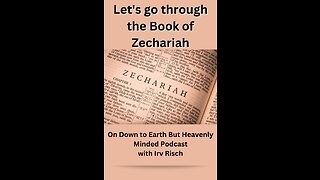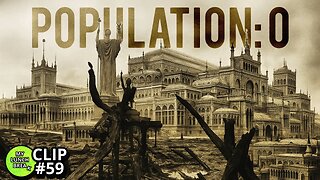Premium Only Content

Light From the Land of the Spinx by H. Forbes Witherby, Chapter 33
Light from the Land of the Sphinx
H. Forbes WitherbyPublished 1896 by Elliot Stock.
If you don’t want to read this long description, I have it in the Preface to this writing in the first recording.
This volume was originally intended to offer the Bible student, who may not have the opportunity of referring to expensive works on modern discoveries in Egypt, references from such works, together with illustrations from the monuments, which would assist in following the writings of Moses; but the materials accumulated with the work, and it was found to be impossible not to enlarge the scope of the book. The reader who loves the writings of Moses will find in the notes contained in this volume important and reliable information, which has been obtained from works of the greatest value; and in the illustrations from the monuments, he will have before him authorities which cannot be disputed. The index should be consulted before the book is read, for it outlines a variety of subjects that must ever fire the mind of the Bible student with enthusiasm and fill it with suggestions. It directs attention to the works of learned authorities, upon whose profound research the arrangement of facts found in this volume is built up.
Taking the Bible narrative of Israel’s exodus from Egypt to their establishment before Jehovah at Horeb, as it stands — which is the only honest way for the first reading of any book — a plain though marvelous tale unfolds itself. By the aid of such side-lights as the ancient monuments and writings of Egypt afford, much of that which appears to be mysterious shapes itself into the everyday life of the past, and the movements of the Divine Hand in relation to that life are made clearly visible. The structure of the story forbids the removal of any one of its parts. To eliminate portions here and there is to criticize the masterpiece of the sculptor by lopping off its limbs or mutilating its face. The energetic hand of the writer delineates that which he actually saw and describes that which he himself and the men around him felt. The eye-witness is continually present in the story; none but he could describe the manner of Pharaoh in his might and pride; or the route taken by Israel from Egypt to Horeb. That the writer was a man of the day of which he writes is shown by his words, for he occasionally uses Egyptian words, which formed Israel’s only means of conveying ideas that pertained to Egypt, before they became a nation. Again, none but a worker from nature could with a few rapid touches portray scenes and characters as does Moses. The work is living and energetic, painted on the spot, done from life; yet the scheme of the whole story — its grandeur and its simplicity, it's the unveiling of man and its revealing of God, its moral teachings and its eternal principles, it's the painting of the past and its picturing of the future — is to be attributed to a greater than Moses: it is the production of the Divine Mind, for its author is God.
The present writer has selected certain portions from the inspired records and has woven around them some of the more general facts which science has given over to the general reader, and he has also introduced, here and there, broad principles which are afforded by the Scriptures, and particularly those of the New Testament.
-
 19:51
19:51
Down to Earth But Heavenly Minded Podcast
2 years agoPart 5, Zechariah 9 to 11 , on Down to Earth But Heavenly Minded Podcast
73 -
 LIVE
LIVE
GloryJean
1 hour agoAggressive Solo Gameplay on Mouse & Keyboard 🖱️ 6.7 K/D
15 watching -
 LIVE
LIVE
The Pascal Show
31 minutes agoBREAKING! Mass Shooting At Annunciation Church In Minneapolis Multiple Shot
59 watching -
 1:43:04
1:43:04
Dear America
2 hours agoNo More IRS!! Tariffs Bring In Over $500 BILLION! + Taylor Swift Got ENGAGED… This Is A Nightmare!!
75.2K66 -
 LIVE
LIVE
Caleb Hammer
18 hours agoHe Just Sucks… | Financial Audit
62 watching -
 LIVE
LIVE
MYLUNCHBREAK CHANNEL PAGE
1 hour agoThe Population Was ZERO
322 watching -
 LIVE
LIVE
Wendy Bell Radio
6 hours agoTrump Cracks The Barrel
7,619 watching -
 LIVE
LIVE
The Big Mig™
2 hours ago2020 Election Fraud Burn Bags Discovered
5,142 watching -
 LIVE
LIVE
Law&Crime
1 hour agoLIVE: Adelson Matriarch Murder Trial — FL v. Donna Adelson — Day 4
136 watching -
 LIVE
LIVE
Badlands Media
10 hours agoBadlands Daily: August 27, 2025
3,649 watching